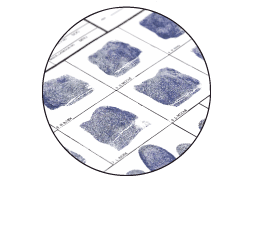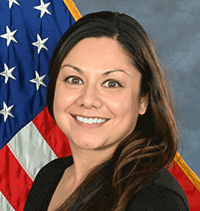Discipline Overview:
Tenprint examiners are friction ridge examiners and perform a variety of tasks including, but not limited to, classifying fingerprints from known sources, performing fingerprint comparisons utilizing rolled and/or flat impressions from known sources, analyzing and evaluating questionable identity cases, preparing written reports and testifying in court, and capturing legible fingerprints via electronic/Livescan or traditional ink methods from known sources.
Tenprint examination involves fingerprint and palmprint impressions from known sources. With latent print examination, the fingerprint and palmprint impressions are from unknown sources.
Tenprint examiners play a key role in maintaining accurate known fingerprint and palmprint records. These records are part of several databases in which latent fingerprint and palmprint impressions are searched against to identify potential sources.

Tenprint Identification Subcommittee Chair

Christie VanAndel, NE, USA
Committee MembersReturn to Forensic Disciplines
Qualifications:
Individuals seeking to become a tenprint examiner are generally expected to have knowledge, classroom or practical experience in the analysis, comparison, and accurate identification of fingerprints of varying quality. It is also beneficial to have acquired fingerprinting skills and the ability to recognize the characteristics of a quality fingerprint impression, and knowledge of the technology, techniques, and best practices for the capture, classification, examination, and identification of fingerprints or friction ridge detail.
Knowledge of Automated Fingerprint Identification System (AFIS) or Automated Biometric Identification System (ABIS), electronic/Livescan and traditional ink methods of capturing legible fingerprints, detention records systems, warrant systems, and computerized criminal history record systems is also advantageous in this field.
Working knowledge of laws, policies, and procedures regarding the use and dissemination of criminal history data, courtroom testimony, and skill in completing work assignments and documenting information with a high degree of accuracy are also useful.
Highly desired qualifications include a certificate or degree in criminal justice or forensic discipline. Additional desired qualifications include previous work experience with using electronic/Livescan or traditional ink methods of capturing legible fingerprints, detention records and warrant systems, AFIS/ABIS, testifying in court and computerized criminal history systems.
Certification:
The Tenprint Identification discipline has an IAI Forensic Certification available, Tenprint Fingerprint Certification. Certification consists of a rigorous educational process, a certification procedure, and re-certification requirements. More detailed information about the certification process and contact information for the Tenprint Fingerprint Certification Board can be found on the Tenprint Fingerprint Certification homepage
Standards:
The Academy Standards Board has published both standards and best practice recommendations for the friction ridge community. Visit their website, Academy Standards Board to find published documents from the Friction Ridge Consensus Body.
The Organization of Scientific Area Committees for Forensic Science (OSAC) has a number of proposed standards and best practice recommendations developed by the Physics-Pattern Interpretation Scientific Area Committee (SAC)/Friction Ridge Subcommittee. Visit the OSAC Registry website to find these documents.
Resources:
Below are some additional resources related to the Tenprint Identification discipline:
Reading Materials:
For a more comprehensive list, please refer to Section 8.8 Tenprint Certification of the Certification Program Operations Manual.
- The Science of Fingerprints, United States Department of Justice
- Quantitative - Qualitative Friction Ridge Analysis, David R. Ashbaugh
- The Fingerprint Sourcebook, United States Department of Justice
Publications:
Employment:
Tenprint examiners can find employment in civil, law enforcement, and private organizations located at local city, state, and country locations. Refer to the IAI’s current Job Listings homepage for more information.
Websites:
- Federal Bureau of Information
- Biometric Training
- Recording Legible Fingerprints
- Ordering Fingerprint Cards and Training Aids
- Electronic Biometric Transmission Specification (EBTS)
- The Organization of Scientific Area Committees for Forensic Science (OSAC)
- OSAC Overview
- Organization Structure, Physics/Pattern Interpretation Scientific Area Committee
- OSAC Registry
- National Institute of Standards and Technology (NIST)
- Data Format for the Interchange of Fingerprint, Facial & Other Biometric Information ANSI/NIST ITL 1-2011 NIST Special Publication 500-290 Edition 2
- European Network of Forensic Science Institutes (ENFSI)
- Best Practice Manuals and Forensic Guidelines – Fingerprints
- Biometric Update
- Webinars & White Papers
- United Kingdom
- Agencies and other public bodies – Forensic Science Regulator
- Canadian Friction Ridge Working Group
- Agencies and other public bodies – Forensic Science Regulator
Contact Us:
For further information about becoming more involved in the Tenprint Identification discipline and presenting tenprint-related content at the annual educational conference, contact:
Christie VanAndel
Chair, TPI Science and Practice Subcommittee